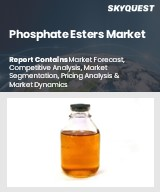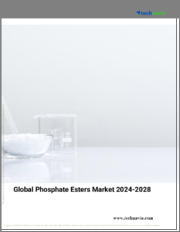
|
시장보고서
상품코드
1796124
인산 에스테르 시장 규모, 점유율, 성장 분석 : 용도별, 제품별, 순도 레벨별, 지역별 - 산업 예측(2025-2032년)Phosphate Esters Market Size, Share, and Growth Analysis, By Application (Flame Retardants, Plasticizers), By Product (Tricresyl Phosphate (TCP), Triphenyl Phosphate (TPP)), By Purity Level, By Region - Industry Forecast 2025-2032 |
||||||
세계의 인산 에스테르 시장 규모는 2023년에 34억 달러로 평가되며, 2024년 35억 4,000만 달러에서 2032년에는 48억 8,000만 달러로 성장하며, 예측 기간(2025-2032년)의 CAGR은 4.1%로 성장할 전망입니다.
세계 인산염 에스테르 시장은 다양한 최종 용도 분야에 맞는 고성능 친환경 난연제에 대한 수요 증가에 힘입어 괄목할 만한 성장세를 보이고 있습니다. 제조업체와 소비자는 지속가능성 목표에 부합하는 동시에 엄격한 안전 규정을 충족하는 배합을 우선시하고 있습니다. 이러한 변화는 컴팩트한 디자인과 열 안정성 향상이 중요한 전자 분야에서 특히 두드러집니다. 유해물질에 대한 규제 강화로 인해 업계는 보다 친환경적인 화학 혁신에 박차를 가하고 있습니다. 바이오 유래 인산염과 디지털 제제 플랫폼의 출현은 기업이 실시간 분석을 활용하여 분자 구조를 최적화하고 더 나은 성능을 달성하는 데 있으며, 큰 기회를 제공합니다. 또한 비바이오소재에서 바이오소재로의 전환이 가속화되고 있으며, 생산자들은 규제 준수와 시장 수요를 모두 충족하는 지속가능한 제품을 효율적으로 개발할 수 있습니다.
목차
서론
- 분석 목적
- 시장 범위
- 정의
분석 방법
- 정보 조달
- 2차·1차 데이터 방법
- 시장 규모 예측
- 시장 상정과 제약
개요
- 시장 개요와 전망
- 수급 동향 분석
- 부문별 기회 분석
시장 역학과 전망
- 시장 개요
- 시장 규모
- 시장 역학
- 촉진요인과 기회
- 억제요인과 과제
- Porter의 산업 분석
시장의 주요 인사이트
- 주요 성공 요인
- 경쟁의 정도
- 주요 투자 기회
- 시장 에코시스템
- 시장의 매력 지수(2024년)
- PESTEL 분석
- 거시경제 지표
- 밸류체인 분석
- 가격 분석
- 사례 연구
세계의 인산 에스테르 시장 규모·CAGR : 용도별(2025-2032년)
- 시장 개요
- 난연제
- 가소제
- 윤활유
- 유압작동유
- 기타
세계의 인산 에스테르 시장 규모·CAGR : 제품별(2025-2032년)
- 시장 개요
- Tricresyl Phosphate(TCP)
- Triphenyl Phosphate(TPP)
- Cresyl Diphenyl Phosphate(CDP)
- Alkyl Phosphate(APP)
- 기타
세계의 인산 에스테르 시장 규모·CAGR : 순도 레벨별(2025-2032년)
- 시장 개요
- 고순도(99% 이상)
- 중순도(95-99%)
- 저순도(95% 미만)
세계의 인산 에스테르 시장 규모·CAGR(2025-2032년)
- 북미
- 미국
- 캐나다
- 유럽
- 독일
- 스페인
- 프랑스
- 영국
- 이탈리아
- 기타 유럽
- 아시아태평양
- 중국
- 인도
- 일본
- 한국
- 기타 아시아태평양
- 라틴아메리카
- 브라질
- 기타 라틴아메리카
- 중동 및 아프리카
- GCC 국가
- 남아프리카공화국
- 기타 중동 및 아프리카
경쟁 구도
- 상위 5사의 비교
- 주요 기업의 시장 포지셔닝(2024년)
- 주요 기업이 채택한 전략
- 시장의 최근 동향
- 주요 기업의 시장 점유율(2024년)
- 주요 기업의 개요
- 기업 개요
- 제품 포트폴리오 분석
- 부문별 점유율 분석
- 매출의 전년대비 비교(2022-2024년)
주요 기업 개요
- Eastman Chemical Company(미국)
- Solvay S.A.(벨기에)
- LANXESS GmbH(독일)
- Albemarle Corporation(미국)
- Croda International Plc(영국)
- Afton Chemical Corporation(미국)
- Clariant AG(스위스)
- Songwon Industrial Co., Ltd.(한국)
- AkzoNobel N.V.(네덜란드)
- TCI Chemicals(일본)
- ICL Group Ltd.(이스라엘)
- Evonik Industries AG(독일)
- PMC Group(이탈리아)
- Arkema S.A.(프랑스)
결론과 제안
KSA 25.08.29Global Phosphate Esters Market size was valued at USD 3.4 billion in 2023 and is poised to grow from USD 3.54 billion in 2024 to USD 4.88 billion by 2032, growing at a CAGR of 4.1% during the forecast period (2025-2032).
The global phosphate esters market is experiencing notable growth fueled by the increasing demand for high-performance, eco-friendly flame retardants tailored for various end-use sectors. Manufacturers and consumers are prioritizing formulations that satisfy rigorous safety regulations while aligning with sustainability goals. This shift is particularly prominent in electronics, where compact designs and enhanced thermal stability are crucial. Stricter regulatory measures targeting harmful materials are pushing the industry towards greener chemistry innovations. The emergence of bio-derived phosphate esters and digital formulation platforms presents significant opportunities, as companies leverage real-time analytics to optimize molecular structures for better performance. Additionally, the transition from non-bio to bio-sourced materials is accelerating, enabling producers to develop sustainable products that meet both regulatory compliance and market needs efficiently.
Top-down and bottom-up approaches were used to estimate and validate the size of the Global Phosphate Esters market and to estimate the size of various other dependent submarkets. The research methodology used to estimate the market size includes the following details: The key players in the market were identified through secondary research, and their market shares in the respective regions were determined through primary and secondary research. This entire procedure includes the study of the annual and financial reports of the top market players and extensive interviews for key insights from industry leaders such as CEOs, VPs, directors, and marketing executives. All percentage shares split, and breakdowns were determined using secondary sources and verified through Primary sources. All possible parameters that affect the markets covered in this research study have been accounted for, viewed in extensive detail, verified through primary research, and analyzed to get the final quantitative and qualitative data.
Global Phosphate Esters Market Segments Analysis
Global Phosphate Esters Market is segmented by Application, Product, Purity Level and region. Based on Application, the market is segmented into Flame Retardants, Plasticizers, Lubricants, Hydraulic Fluids and Others. Based on Product, the market is segmented into Tricresyl Phosphate (TCP), Triphenyl Phosphate (TPP), Cresyl Diphenyl Phosphate (CDP), Alkyl Phosphate (APP) and Others. Based on Purity Level, the market is segmented into High Purity (99% and above), Medium Purity (95-99%) and Low Purity (below 95%). Based on region, the market is segmented into North America, Europe, Asia Pacific, Latin America and Middle East & Africa.
Driver of the Global Phosphate Esters Market
The global phosphate esters market is significantly influenced by the increasing adoption of these compounds as flame retardants, notably in the electronics and construction sectors. Their inherent thermal stability and low volatility render them essential for applications such as circuit boards, insulation materials, and synthetic polymers. As fire safety regulations become more stringent, manufacturers are increasingly turning to phosphate-based solutions to ensure compliance without compromising on performance. Furthermore, the compatibility of phosphate esters with a diverse range of substrates enhances their role as a preferred additive in numerous materials, contributing to the sustained demand and growth of this market.
Restraints in the Global Phosphate Esters Market
The production of high-purity phosphate esters is significantly constrained by the elevated costs associated with manufacturing. The volatility in the prices of essential raw materials like alcohols and phenols poses a risk to profit margins. Furthermore, the need for specialized synthesis methods and purification processes results in considerable capital investments related to infrastructure. This creates challenges for smaller or niche companies, limiting their ability to compete effectively and advance within the market. Consequently, these players struggle to explore new market opportunities and innovate, particularly in regions where price sensitivity is a prominent concern.
Market Trends of the Global Phosphate Esters Market
The Global Phosphate Esters market is witnessing a notable shift towards high purity and lower toxicity formulations, driven by the stringent safety and environmental standards across various sectors, including electronics, aerospace, and medical-grade lubricants. End users are increasingly prioritizing sustainable sourcing, prompting manufacturers to explore innovative purification methods and alternative feedstock options that minimize residual contaminants. This proactive approach not only aligns with regulatory compliance but also enhances product longevity in sensitive environments. As demand for these advanced materials grows, the market is likely to see continued investment in research and development to cater to the evolving needs of environmentally conscious consumers.
Table of Contents
Introduction
- Objectives of the Study
- Scope of the Report
- Definitions
Research Methodology
- Information Procurement
- Secondary & Primary Data Methods
- Market Size Estimation
- Market Assumptions & Limitations
Executive Summary
- Global Market Outlook
- Supply & Demand Trend Analysis
- Segmental Opportunity Analysis
Market Dynamics & Outlook
- Market Overview
- Market Size
- Market Dynamics
- Drivers & Opportunities
- Restraints & Challenges
- Porters Analysis
- Competitive rivalry
- Threat of substitute
- Bargaining power of buyers
- Threat of new entrants
- Bargaining power of suppliers
Key Market Insights
- Key Success Factors
- Degree of Competition
- Top Investment Pockets
- Market Ecosystem
- Market Attractiveness Index, 2024
- PESTEL Analysis
- Macro-Economic Indicators
- Value Chain Analysis
- Pricing Analysis
- Case Studies
Global Phosphate Esters Market Size by Application & CAGR (2025-2032)
- Market Overview
- Flame Retardants
- Plasticizers
- Lubricants
- Hydraulic Fluids
- Others
Global Phosphate Esters Market Size by Product & CAGR (2025-2032)
- Market Overview
- Tricresyl Phosphate (TCP)
- Triphenyl Phosphate (TPP)
- Cresyl Diphenyl Phosphate (CDP)
- Alkyl Phosphate (APP)
- Others
Global Phosphate Esters Market Size by Purity Level & CAGR (2025-2032)
- Market Overview
- High Purity (99% and above)
- Medium Purity (95-99%)
- Low Purity (below 95%)
Global Phosphate Esters Market Size & CAGR (2025-2032)
- North America (Application, Product, Purity Level)
- US
- Canada
- Europe (Application, Product, Purity Level)
- Germany
- Spain
- France
- UK
- Italy
- Rest of Europe
- Asia Pacific (Application, Product, Purity Level)
- China
- India
- Japan
- South Korea
- Rest of Asia-Pacific
- Latin America (Application, Product, Purity Level)
- Brazil
- Rest of Latin America
- Middle East & Africa (Application, Product, Purity Level)
- GCC Countries
- South Africa
- Rest of Middle East & Africa
Competitive Intelligence
- Top 5 Player Comparison
- Market Positioning of Key Players, 2024
- Strategies Adopted by Key Market Players
- Recent Developments in the Market
- Company Market Share Analysis, 2024
- Company Profiles of All Key Players
- Company Details
- Product Portfolio Analysis
- Company's Segmental Share Analysis
- Revenue Y-O-Y Comparison (2022-2024)
Key Company Profiles
- Eastman Chemical Company (USA)
- Company Overview
- Business Segment Overview
- Financial Updates
- Key Developments
- Solvay S.A. (Belgium)
- Company Overview
- Business Segment Overview
- Financial Updates
- Key Developments
- LANXESS GmbH (Germany)
- Company Overview
- Business Segment Overview
- Financial Updates
- Key Developments
- Albemarle Corporation (USA)
- Company Overview
- Business Segment Overview
- Financial Updates
- Key Developments
- Croda International Plc (UK)
- Company Overview
- Business Segment Overview
- Financial Updates
- Key Developments
- Afton Chemical Corporation (USA)
- Company Overview
- Business Segment Overview
- Financial Updates
- Key Developments
- Clariant AG (Switzerland)
- Company Overview
- Business Segment Overview
- Financial Updates
- Key Developments
- Songwon Industrial Co., Ltd. (South Korea)
- Company Overview
- Business Segment Overview
- Financial Updates
- Key Developments
- AkzoNobel N.V. (Netherlands)
- Company Overview
- Business Segment Overview
- Financial Updates
- Key Developments
- TCI Chemicals (Japan)
- Company Overview
- Business Segment Overview
- Financial Updates
- Key Developments
- ICL Group Ltd. (Israel)
- Company Overview
- Business Segment Overview
- Financial Updates
- Key Developments
- Evonik Industries AG (Germany)
- Company Overview
- Business Segment Overview
- Financial Updates
- Key Developments
- PMC Group (Italy)
- Company Overview
- Business Segment Overview
- Financial Updates
- Key Developments
- Arkema S.A. (France)
- Company Overview
- Business Segment Overview
- Financial Updates
- Key Developments

















